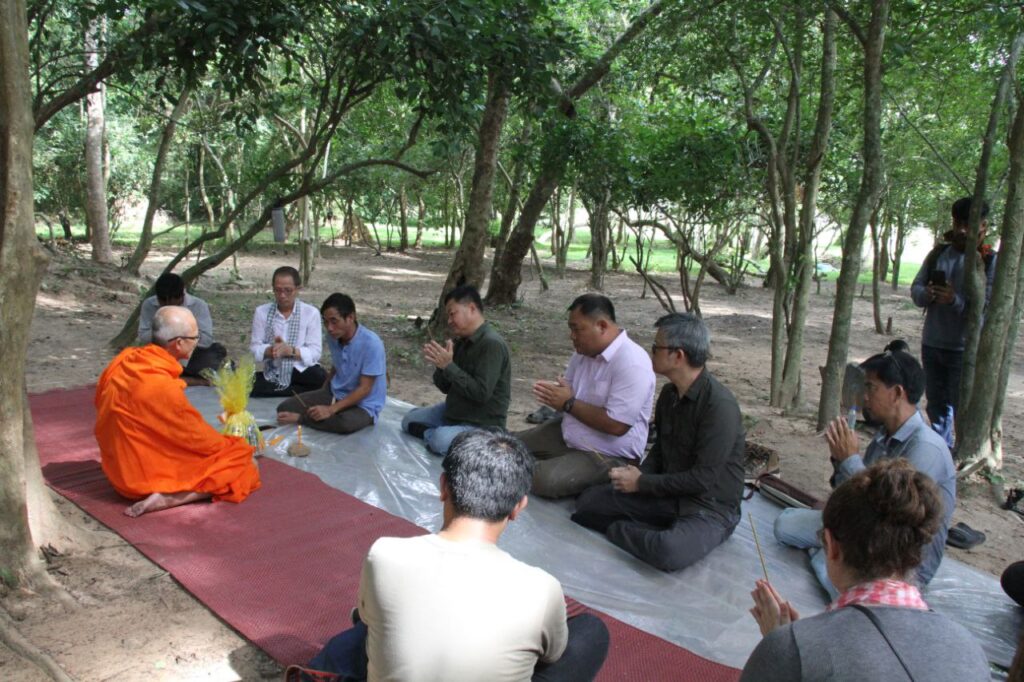អាជ្ញាធរជាតិអប្សរា សាកលវិទ្យាល័យហាវ៉ៃ រួមនិងសាកលវិទ្យាល័យកាលីហ្វ័រញ៉ានៃសហរដ្ឋអាមេរិក បានសហការធ្វើកំណាយបុរាណវិទ្យាស្រាវជ្រាវរួមគ្នាមួយនៅទីទួលវិហារបុរាណស្ថិតនៅទិសនិរតីមិនឆ្ងាយប៉ុន្មានពីប្រាង្គប្រាសាទអង្គរវត្ត។ ការស្រាវជ្រាវនេះ ធ្វើឡើងដើម្បីសិក្សាអំពីទួលមនុស្សរស់នៅក្នុងទីក្រុងអង្គរផង ព្រមទាំងចង់ដឹងថា តើមានការផ្លាស់ប្ដូរអ្វីខ្លះនៅក្នុងសហគមន៍ទីក្រុងនៅពេលមានការផ្លាស់ប្ដូរសាសនា និងការប្តូរទីក្រុងពីតំបន់អង្គរទៅភាគខាងត្បូងផង។
លោកបណ្ឌិត ហេង ពិភាល់ បុរាណវិទូនៃសាកលវិទ្យាល័យហាវ៉ៃ និងជាប្រធានគម្រោងស្រាវជ្រាវបានឱ្យដឹងថា ការធ្វើកំណាយស្រាវជ្រាវពេលនេះ គឺធ្វើឡើងនៅលើរចនាសម្ពន្ធនៃខឿនព្រះវិហារបុរាណ។ រចនាបថសន្លឹកសីមាអាចឱ្យយេីងកំណត់អាយុកាលទួលវិហារនេះទៅអំឡុងសតវត្សរ៍ទី១៤ ដល់ទី១៦ ដូច្នេះ ព្រះវិហារពុទ្ធសាសនាថេរវាទបុរាណនេះ គេកសាងនៅក្នុងបរិវេណប្រាសាទដែលឧទ្ទិសទៅដល់អាទិទេពធំនៃព្រហ្មញ្ញសានា គឺព្រះវិស្ណុ ឬព្រះនារាយណ៍។ បណ្ឌិតរូបនេះបញ្ជាក់ទៀតថា តាមការស្រាវជ្រាវពីមុនបង្ហាញថា នៅក្នុងបរិវេណប្រាសាទអង្គរវត្ត គឺជាកូនក្រុងមួយរបស់រាជធានីអង្គរ ដូច្នេះហើយទើបខ្មែរយើងអ្នកសៀមរាបហៅថា «អង្គរតូច»។ កូនក្រុងនេះ មានប្រព័ន្ធទួល ស្រះ និងផ្លូវខ្វាត់ខ្វែងជាក្រឡាចត្រង្គនៅក្នុងបរិវេណប្រាសាទអង្គរវត្ត។ ប្រសិនជាមើលតាមស្នាមក្រឡាចត្រង្គរបស់ក្រុងនេះ យើងឃើញថា ទួលព្រះវិហារធ្វើនៅលើទួលដែលធ្លាប់ជាទួលផ្ទះមានមនុស្សរស់នៅតាំងពីសតវត្សរ៍ទី១២មកម៉្លេះ។ ដូច្នេះហើយ អ្នកស្រាវជ្រាវចម្រុះស្ថាប័នចង់ដឹងថា តើទីតាំងមនុស្សរស់នៅកន្លែងនេះ អាចបន្សល់នូវភស្តុតាងអ្វីខ្លះទាក់ទងជាមួយនិងការផ្លាស់ប្តូរសាសនាពីព្រហ្មញ្ញ និងពុទ្ធសាសនាមហាយានទៅជាពុទ្ធសាសនាថេរវាទនៅចុងសម័យអង្គរ ដែលស្រុកខ្មែរកំពុងតែប្រតិបត្តិរហូតមកដល់សព្វថ្ងៃនេះ?
គេដឹងថា ជាយូរមកហើយអ្នកភូមិ អ្នកក្រុងអង្គរ ធ្លាប់គោរពបូជាលទ្ធិព្រហ្មញ្ញសាសនា ដូច្នេះ សំណួរពីក្រុមអ្នកស្រាវជ្រាវគឺថា តើខឿនព្រះវិហារព្រះពុទ្ធសាសនានៅក្នុងបរិវេណប្រាសាទអង្គរវត្តនេះ គេធ្វើឡើងដើម្បីអ្វី? សម្រាប់អ្នកណា? ឬមួយក៏នៅអំឡុងសតវត្សរ៍ទី១៣-១៤ ទីក្រុងអង្គរបានដូរពីការគោរពព្រហ្មញ្ញសាសនាមកកាន់ពុទ្ធសាសនាថេរវាទនៅក្នុងពេលដែលទីក្រុងអង្គរនៅមានប្រជាជនរស់នៅច្រើននៅឡើយនោះ? ឬព្រះវិហារនេះគេកសាងនៅសម័យក្រោយនាសតវត្សរ៍ទី១៦ នៅពេលដែលព្រះអង្គច័ន្ទយាងមកក្រុងអង្គរវិញ?
លោកបណ្ឌិត ហេង ពិភាល ឱ្យដឹងទៀតថា តាមការស្រាវជ្រាវព្រះវិហារបុរាណនៃពុទ្ធសាសនាថេរវាទដែលនៅជិតប្រាង្គប្រាសាទអង្គរវត្តនេះ ត្រូវគេទុកចោលយូរធ្វើឱ្យមានខូចខាតនូវរចនាសម្ពន្ធអស់ ព្រមទាំងមានដីចាក់បង្គរដែលលប់ពីលើវិហារនេះស្ទើរទាំងស្រុងទើបយើងពុំដឹងថា តើព្រះវិហារនោះគេសាងសង់ពីអ្វីខ្លះ? រូបរាងយ៉ាងម៉េច? តើមានកម្រាលថ្មឬអត់? តើធ្លាប់មានអ្វីខ្លះនៅទីតាំងនេះ? ក្រុមអ្នកស្រាវជ្រាវមានគោលបំណងធំ គឺប្រមូលយកសំណាកធ្យូង និងសំណាកអរហ្គានិកផ្សេងៗនៅបាតរណ្តៅកំណាយយកទៅវិភាគកំណត់អាយុកាលទៅតាមកាបូន១៤។ កាលណាគេរកឃើញធ្យូងឬឆ្អឹងសត្វយកទៅវិភាគនោះ គេនឹងអាចដឹងថា តើព្រះវិហារបុរាណនៃពុទ្ធសាសនាថេរវាទដែលសាងសង់នៅលើទួលបុរាណនោះ កើតមានតាំងពីជំនាន់ណា?
ក្រុមអ្នកស្រាវជ្រាវ ឱ្យដឹងថានៅបរិវេណនៃប្រាសាទអង្គរវត្ត គេឃើញមានស្លាកស្នាមខឿនព្រះវិហារនៃពុទ្ធសាសនាថេរវាទសម័យបុរាណចំនួន២ គឺទី១នៅទិសនិរតី និងមួយទៀតនៅទិសពាយ័ព្យ ដែលបច្ចុប្បន្ននៅមានសំណង់បុស្បុកតម្កល់ព្រះពុទ្ធមួយអង្គ៕
អត្ថបទ៖ លោក យី សុថា
រូបភាព៖ លោក ហ៊ាប់ គឹមអាន
Excavations at the southwest wall of Angkor Wat to study the location of people living in the Angkorian period and the conversion from Brahmanism to Theravada Buddhism.
APSARA National Authority, the University of Hawaii, and the University of California, USA, have teamed up to conduct a joint archeological excavation at the site of an ancient mound in the southwest of Angkor Wat. This research was conducted to study the population of people living in Angkor, as well as to see what changes in the urban community during the religious change and the relocation of the city from Angkor to the south.
Dr. Heng Pipal, an archaeologist from the University of Hawaii and head of the research project, said the excavations were now based on the structure of the ancient vihara. The style of the Bai Sema Boundary Marker allows us to determine the age of the vihara’s mound during the 14th to 16th centuries, so this ancient Theravada Buddhist temple was built on the site of a temple dedicated to the great deity of Brahmanism, Vishnu or Narayan. He added that previous research has shown that the Angkor Wat temple complex is a suburb of Angkor, which is why Cambodians in Siem Reap call it “Angkor Toch”. The town has a system of mounds, ponds, and roads of grids in the Angkor Wat complex. If you look at the grid of this city, we see that the Buddhist vihara was built on a mound that used to be inhabited since the 12th century. Therefore, the researchers want to know what evidence the human settlements may have left in connection with the conversion of Brahmanism and Mahayana Buddhism to Theravada Buddhism in the late Angkorian period, which Cambodia is still practicing today.
It is known that the villagers of Angkor have long worshiped Hinduism, so the question from the researchers is, what is the purpose of the Buddhist temple in the area of Angkor Wat? For whom? Or during the 13th-14th centuries, Angkor switched from Hinduism to Theravada Buddhism while Angkor was still densely populated? Or was this Buddhist vihara built later in the 16th century when King Preah Ang Chan returned to Angkor?
Dr. Heng Pipheal said that according to the research, the ancient temple of Theravada Buddhism near Angkor Wat was left for a long time, causing damage to the structure and the accumulated soil that covered the vihara almost completely, we do not know what the vihara was built of. What does it look like? Is there a stone floor? Whatever happened at this location? The researchers’ main goal is to collect coal and other organic samples from the bottom of the crater and analyze them to determine the age of the carbon 14. When charcoal or animal bones are found for analysis, it is possible to find out from which generation the ancient vihara of Theravada Buddhism was built on the ancient mound.
Researchers say that in the area of Angkor Wat, there are two traces of ancient Theravada Buddhist viharas, one in the southwest and the other in the northwest, where there is still a shrine to keep the Buddha statue.
Article: Mr. Yi Sotha
Photos: Mr. Hap Kim An





